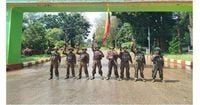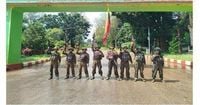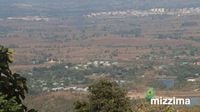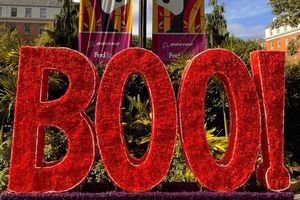In a dramatic escalation of Myanmar’s ongoing civil conflict, the country’s military has announced the recapture of two strategically vital locations from ethnic armed groups, marking a significant—if deeply contested—turning point in the nation’s fractured landscape. These operations, which unfolded in late September and early October 2025, have not only shifted control of key towns and camps but also triggered fresh waves of violence and displacement, leaving thousands of civilians in peril and raising urgent questions about the future of Myanmar’s war-torn regions.
According to state-run media cited by the Associated Press and other international outlets, Myanmar’s military declared on October 1, 2025, that it had retaken Kyaukme, a major district capital in Shan State, after a grueling three-week operation. The town, located roughly 115 kilometers northeast of Mandalay—the country’s second-largest city—had been under the control of the Ta’ang National Liberation Army (TNLA) since August 2024. The TNLA is a prominent member of the Three Brotherhood Alliance, a coalition of ethnic armed groups that have been locked in a decades-long struggle for greater autonomy from Myanmar’s central government.
The military’s claim of victory in Kyaukme, though not independently verified due to restricted journalist access, has gone unchallenged by other sources. The army’s push to retake the town is part of a broader campaign to reclaim territory ahead of national elections slated to begin on December 28, 2025—a move widely seen as an attempt to consolidate power and project control in the face of persistent resistance.
Kyaukme’s strategic significance cannot be overstated. The town sits on a major highway that serves as a trading artery between central Myanmar and China, making it a coveted prize for both the military and the ethnic militias. Since August 2024, the TNLA and its allies had used Kyaukme as a foothold to expand their influence in northern Shan State. However, the military’s recent surge in ground operations and airstrikes appears to have tipped the balance.
State media reports, including those from Myanma Alinn, described the recapture as the culmination of a meticulously planned offensive. Photographs published showed uniformed soldiers occupying key sites in the town. The military, for its part, has pledged to restore administrative functions and facilitate the safe return of residents who fled during the fighting. Yet, these assurances ring hollow for many locals, especially in light of accusations from the TNLA that the army used heavy weapons and airstrikes during the assault, setting official buildings ablaze and sparking fierce clashes in nearby villages.
“They attacked Kyaukme with airstrikes and heavy weapons, causing fires and fierce fighting in nearby villages,” the TNLA alleged via its Telegram channel, as reported by the Associated Press. The group did not immediately respond to further requests for comment, underscoring the fog of war that now blankets the region.
The recapture of Kyaukme is just the latest episode in a broader theater of conflict that has seen the Three Brotherhood Alliance—comprising the TNLA, the Myanmar National Democratic Alliance Army (MNDAA), and the Arakan Army—seize and hold swathes of territory since October 2023. The alliance’s momentum, however, slowed earlier in 2025 following a series of China-brokered ceasefires, which allowed the military to retake other major towns such as Lashio in April and Nawnghkio in July. Still, the underlying tensions remain unresolved, and the risk of renewed violence looms large as the promised elections approach.
While attention has been focused on Shan State, fierce battles have also erupted along Myanmar’s eastern border, particularly near Lay Kay Kaw in Karen State. On September 29, 2025, military sources confirmed to Mizzima that junta forces had recaptured Yaykangon hill camp, a key outpost near Lay Kay Kaw town and just south of Myawaddy, close to the Thai-Myanmar border. The camp had previously been controlled by the Karen National Union (KNU), another major ethnic armed group.
The operation to retake Yaykangon, which began on September 22, was a joint effort between the junta and the Karen Border Guard Force (BGF). In a chilling escalation, junta forces reportedly set fire to Ward 6 of Lay Kay Kaw town following the camp’s recapture, a move that has intensified the humanitarian crisis in the area.
Eyewitnesses and resistance fighters described a morning assault marked by the deployment of five kamikaze drones—both large fixed-wing models and smaller FPV (First Person View) units—flying overhead. “This morning, five kamikaze drones flew overhead, including large aircraft-style kamikaze drones and smaller FPV drones. The enemy sniper was highly skilled, shooting from around 500 meters. I heard he was a gold medallist,” a revolutionary soldier told Mizzima, painting a vivid picture of the technological and tactical sophistication now on display in Myanmar’s conflict zones.
The violence did not stop with the recapture of the camp. On the afternoon of September 29, two schools in the villages of Hpalu and Minlatpan were struck by kamikaze drones, resulting in significant damage. The previous day, the military had carried out four airstrikes on Lay Kay Kaw town and bombed the Miba Mytta restaurant in Hpalu village. On September 27, a monastery adjacent to Hpalu school was also bombed, further underscoring the indiscriminate nature of the ongoing offensive.
The cumulative toll of these operations has been devastating for civilians. More than 3,000 residents from at least six villages have been displaced, with many seeking refuge along the Thai-Myanmar border. The area remains tense, with fighting continuing on multiple fronts and little sign of respite for those caught in the crossfire.
These latest developments highlight the complex, multi-layered nature of Myanmar’s internal conflicts. The military, emboldened by recent gains and eager to assert its authority ahead of the elections, has intensified its efforts to crush resistance from ethnic armed groups. Meanwhile, those groups—some of which are loosely allied with the People’s Defense Force, a pro-democracy resistance that emerged after the 2021 coup—remain determined to fight for autonomy and self-determination.
As the military moves to restore administrative control in recaptured areas and promises the safe return of displaced residents, skepticism abounds among local populations and international observers alike. The use of heavy weaponry, airstrikes, and drone attacks has not only inflicted heavy casualties but also deepened the mistrust between Myanmar’s military rulers and the country’s myriad ethnic groups.
With national elections on the horizon and no clear path to peace, Myanmar stands at a crossroads. The fate of towns like Kyaukme and Lay Kay Kaw will likely serve as a bellwether for the broader struggle that continues to define the country’s future—a struggle marked by resilience, tragedy, and the enduring hope for a more just and peaceful Myanmar.






